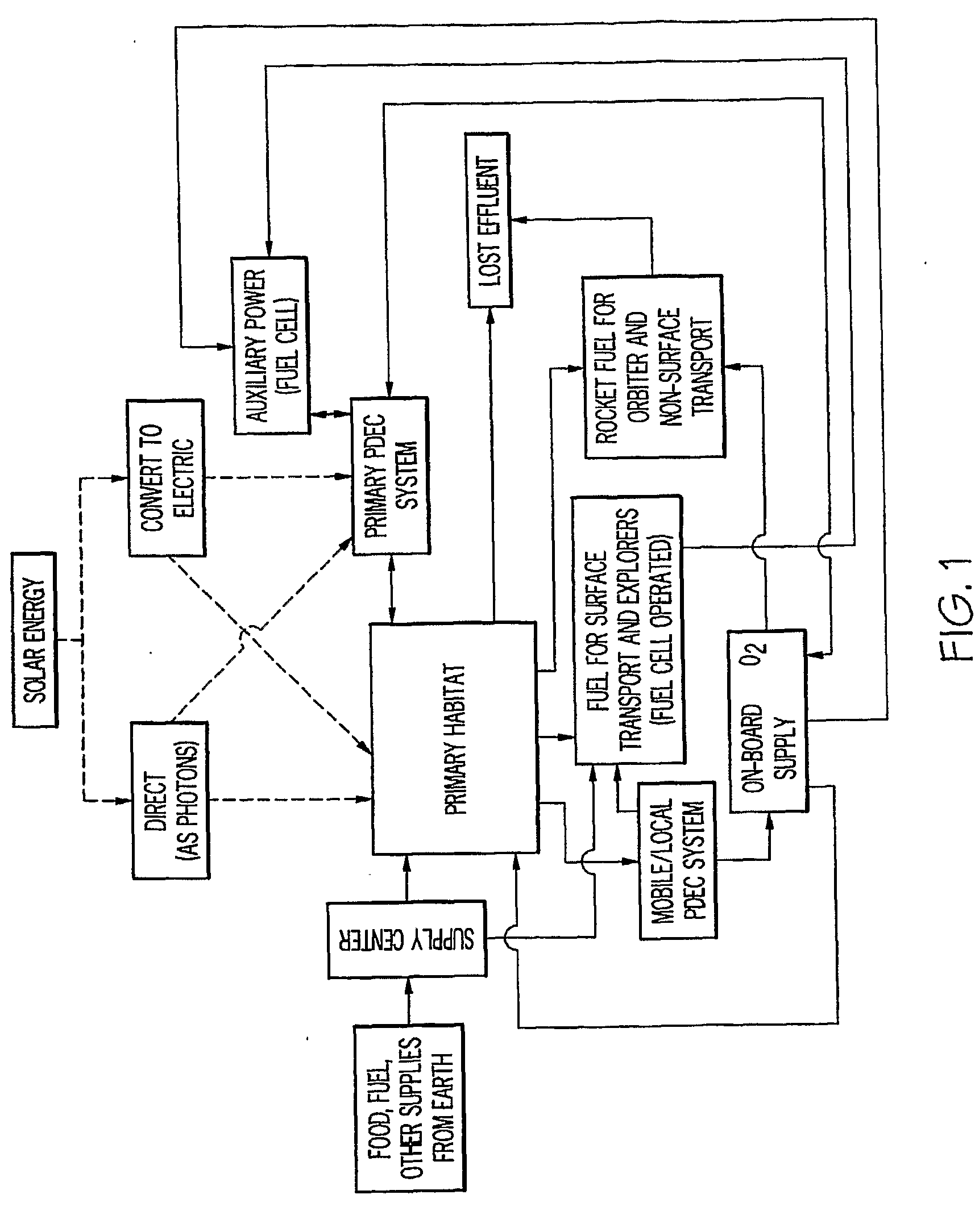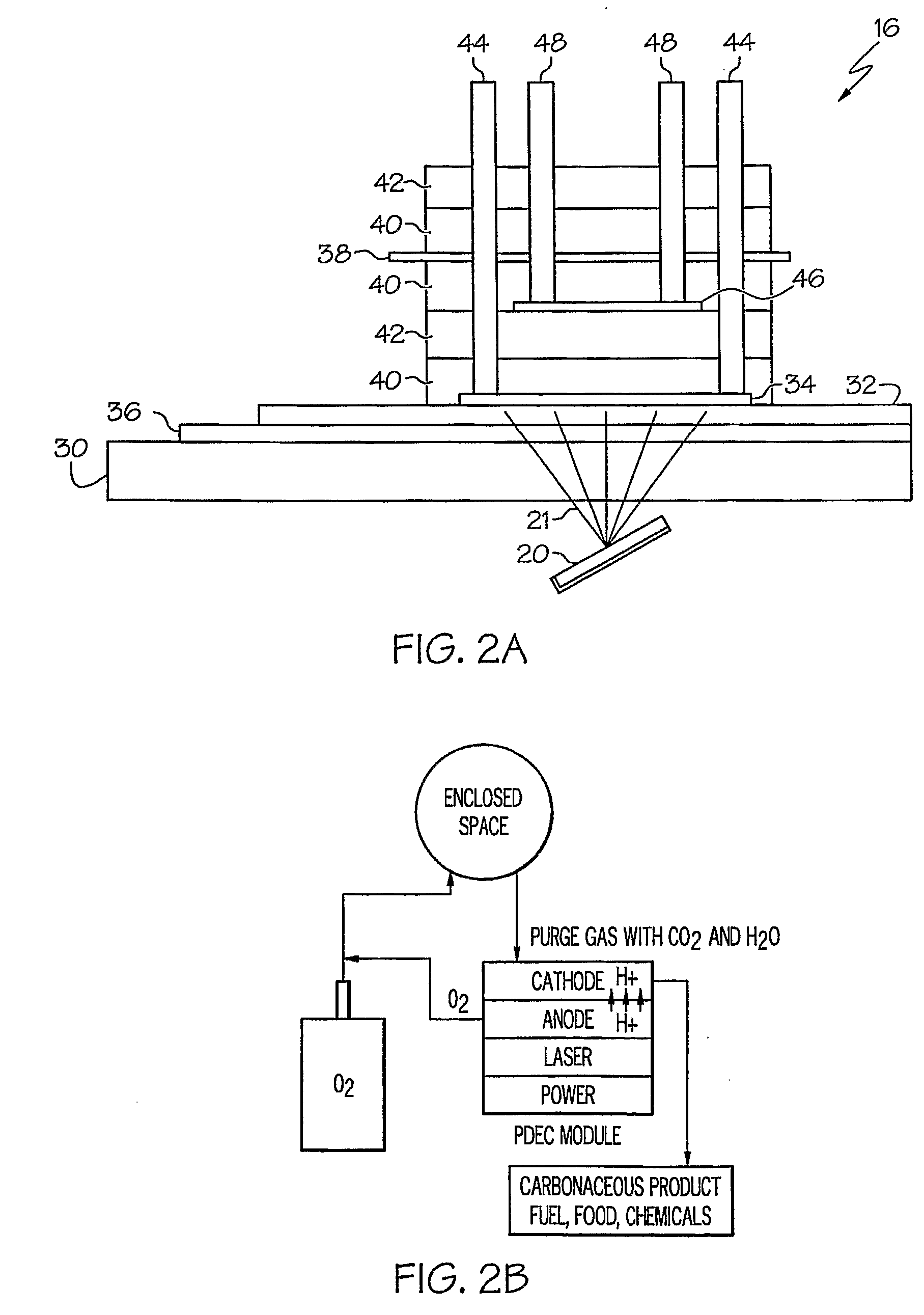Power device and oxygen generator
a generator and power device technology, applied in the field of compact power supply systems, can solve the problems of severely restricted resources on the moon and mars, abundant photons, etc., and achieve the effects of light weight, increased quantum efficiency, and small siz
- Summary
- Abstract
- Description
- Claims
- Application Information
AI Technical Summary
Benefits of technology
Problems solved by technology
Method used
Image
Examples
example 1
Lunar Surface Architecture Material and Energy Requirements
[0038]FIG. 1 shows schematic drawing of one embodiment of a lunar, Mars surface or interplanetary spacecraft habitat and supply depot that appear useful for these or other applications such as submarines, aircraft, underground mining, and the like. As an example, as applied to lunar or Mars surfaces, key features are life support within the primary habitat and support for mobile devices, including surface to orbit as a part of surface to earth transport. The core earth to lunar surface transport requirements are essentially energy in special forms (food and water for crew, oxygen for crew and specialized fuels for surface and orbital transport) in addition to scientific support systems. Energy is available on the lunar surface in the form of sunlight. One objective PDEC / Fuel Cell embodiments disclosed herein is to at least partially replace transported special-form energy with local energy and provide for efficient storage o...
example 2
Key Photolytically Driven Electro-Chemical Reactions for Oxygen Production And CO2 Removal Gas Streams from Fuel Cell Exhaust and Breathing Air By Forming Bicarbonate Solutions
[0147]This example illustrates how CO2 is purged from fuel cell exhaust gases or from accumulations in confined breathing atmospheres while producing oxygen gas from the moisture present in such fluids, liquid or vapor / gas.
Step 1. Photolysis
[0148]
Step 2. Transport of Electrons to Cathode
[0149]
2e−→electrical conductor / semi-conductor film→Cathode (2)
Note that the cathode material of constructed is selected to accomplish the desired electrochemical change for CO2 capture (OH— generation), and / or CO2 reduction to a carbonaceous compound or compounds, and / or reduction of one or more other carbonaceous organic spent fuel cell exhaust constituents. Also note that the fuel cell exhaust may and most likely will still contain unreacted fuel values as complete consumption of fuel may be inefficient for power generation....
example 3
Carbonate-Based Means to Use PDEC to Regenerate Spent FC Fuel to Accomplish FCFR
[0156]In this example, the PDEC substrate is used to accomplish the water conversion to oxygen, hydrogen ions and electrons, which in part drive carbonation chemical changes to capture CO2 from spent fuel cell fuel, reformer off gas, exhaled breathing air, and the like. Upon capture, the CO2 can be reduced to carbonaceous food and / or fuel, for example fuel cell fuel, or regenerated as CO2 gas, preferably under pressure. Such pressurized CO2 is useful for release as a waste to the local environment, even at conditions where significant back pressures exist from ambient carbon dioxide, and is present for example on Mars or in green houses. Another benefit is that it enables the use of lithium hydroxide or lithium hydroxide to remove CO2 from breathing and fuel cell or reformer off gases. The following description describes this preferred aspect of the invention.
[0157]The materials to prepare the device use...
PUM
| Property | Measurement | Unit |
|---|---|---|
| power | aaaaa | aaaaa |
| electrical power | aaaaa | aaaaa |
| energy | aaaaa | aaaaa |
Abstract
Description
Claims
Application Information
 Login to View More
Login to View More - R&D
- Intellectual Property
- Life Sciences
- Materials
- Tech Scout
- Unparalleled Data Quality
- Higher Quality Content
- 60% Fewer Hallucinations
Browse by: Latest US Patents, China's latest patents, Technical Efficacy Thesaurus, Application Domain, Technology Topic, Popular Technical Reports.
© 2025 PatSnap. All rights reserved.Legal|Privacy policy|Modern Slavery Act Transparency Statement|Sitemap|About US| Contact US: help@patsnap.com



